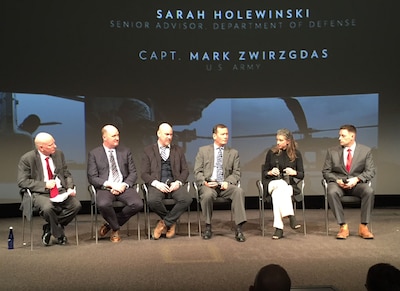By Jim Garamone DoD News, Defense Media Activity
WASHINGTON, Jan. 10, 2018 — Strategic decisions made in the
Pentagon have immediate and far-reaching effects on service members around the
world. National Geographic’s documentary “Chain of Command” shows both sides of
that process.
The eight-part show premiered last night at the Newseum here
-- showing the first episode “By, With, Through.”
The series looks at the war against violent extremism
starting in Mosul, Iraq, and branching out -- in later episodes -- around the
world. The series begins on television on January 15.
The effort began two years ago and has spanned two
administrations, said Courtney Monroe, the chief executive officer for National
Geographic Global Networks, as she introduced the documentary. Videographers
and reporters traveled around the world filming service members doing their
jobs in Iraq, Syria, Afghanistan, Somalia, Niger and in Washington -- where the
strategic decisions are made.
The first episode action’s takes viewers from the Tank --
the Joint Chiefs of Staff’s meeting room in the Pentagon -- to a line company
of the 101st Airborne Division in Mosul working by, with and through Iraqi
allies to liberate East Mosul from the Islamic State of Iraq and Syria. These
are real soldiers doing real jobs in defense of the United States. These troops
are proud of the jobs they are doing and stress that what they are doing is
keeping terrorism away from American shores.
Access
The National Geographic film crews had incredible access,
and Monroe gave a shout-out to Navy Capt. Greg Hicks, then-special assistant
for public affairs to the Chairman, for setting the tone of cooperation between
the news organization and the military. National Geographic and the military
developed trust over the course of the project. The National Geographic crew
received access to some places not usually photographed, such as the Combined
Air Operations Center, and placed a camera aboard an F-22 Raptor doing missions
over Mosul. In the Pentagon, they videotaped inside the Tank, and videotaped
conversations among advisers at an in-house think tank dedicated to developing
strategy.
Geographic videographers traveled with Marine Corps Gen. Joe
Dunford, the chairman of the Joint Chiefs of Staff, and embedded with troops
fighting against extremists. The juxtaposition of those images in the series
drives home the connection between the two.
Hicks, now the acting Navy chief of information, said this
illustrates the vision that National Geographic had when they first approached
him with the idea. He supported the project, “because of their history of
telling great stories, the interlocking elements of what makes us humans. The
chairman’s … emphasis was about making the story about the people on the ground
doing the hard work.”
Army Capt. Mark Zwirzgdas of the 82nd Airborne Division was
featured in the film and spoke as part of the panel. The captain has more than
one deployment to Iraq under his belt, and he noted that his most recent deployment
was fundamentally different to his previous combat tours.
In the past, Zwirzgdas said, the feeling among service
members was that American forces would handle all of it. Now, however, the
understanding is, “This is [the Iraqis’] timeline, this is their plan,” he
said. “We help them execute, we aid that. It’s their country and they should
win.”
A key element in the series depicts the procedures American
and Iraqi service members employ to avoid civilian casualties. This is
especially hard when ISIS uses civilians as human shields.
“Ultimately, it is more important to us to fight the right
way and avoid civilian casualties than it is to get everything as fast as we
can,” Zwirzgdas said. “We struck the right balance with our Iraqi counterparts
understanding the situation.”

No comments:
Post a Comment